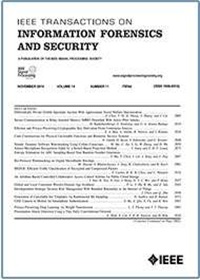Mutual Information Guided Backdoor Mitigation for Pre-Trained Encoders
IF 6.3
1区 计算机科学
Q1 COMPUTER SCIENCE, THEORY & METHODS
IEEE Transactions on Information Forensics and Security
Pub Date : 2025-03-18
DOI:10.1109/TIFS.2025.3550062
引用次数: 0
Abstract
Self-supervised learning (SSL) is increasingly attractive for pre-training encoders without requiring labeled data. Downstream tasks built on top of those pre-trained encoders can achieve nearly state-of-the-art performance. The pre-trained encoders by SSL, however, are vulnerable to backdoor attacks as demonstrated by existing studies. Numerous backdoor mitigation techniques are designed for downstream task models. However, their effectiveness is impaired and limited when adapted to pre-trained encoders, due to the lack of label information when pre-training. To address backdoor attacks against pre-trained encoders, in this paper, we innovatively propose a mutual information guided backdoor mitigation technique, named MIMIC(针对预训练编码器的互信息引导后门缓解技术
自监督学习(SSL)对于不需要标记数据的预训练编码器越来越有吸引力。建立在这些预训练编码器之上的下游任务可以实现近乎最先进的性能。然而,现有的研究表明,SSL预训练的编码器容易受到后门攻击。为下游任务模型设计了许多后门缓解技术。然而,当适应预训练编码器时,由于预训练时缺乏标签信息,它们的有效性受到损害和限制。为了解决针对预训练编码器的后门攻击,本文创新性地提出了一种互信息引导的后门缓解技术,命名为MIMIC(mutual information guided backdoor mitigation for pre-trained encoders)。MIMIC使用潜在的后门编码器作为教师网络,并应用知识蒸馏从它创建一个干净的学生编码器。与现有的知识蒸馏方法不同,MIMIC以随机权重初始化学生,不继承教师网的后门。然后,MIMIC利用每层之间的互信息和提取的特征来定位良性知识在教师网络中的位置,并利用这些信息进行蒸馏,从教师到学生克隆干净的特征。我们从克隆损失和注意力损失两个方面来制作蒸馏损失,目的是在减少后门的同时保持编码器的性能。我们对SSL中的两个后门攻击进行的评估表明,MIMIC可以通过仅利用 $\leq 5$ % of clean pre-training data that is accessible to the defender, surpassing seven state-of-the-art backdoor mitigation techniques. The source code of MIMIC is available at https://github.com/wssun/MIMIC.
本文章由计算机程序翻译,如有差异,请以英文原文为准。
求助全文
约1分钟内获得全文
求助全文
来源期刊

IEEE Transactions on Information Forensics and Security
工程技术-工程:电子与电气
CiteScore
14.40
自引率
7.40%
发文量
234
审稿时长
6.5 months
期刊介绍:
The IEEE Transactions on Information Forensics and Security covers the sciences, technologies, and applications relating to information forensics, information security, biometrics, surveillance and systems applications that incorporate these features
 求助内容:
求助内容: 应助结果提醒方式:
应助结果提醒方式:


